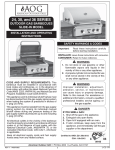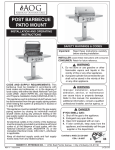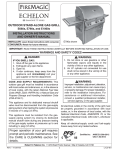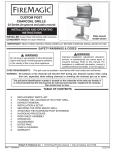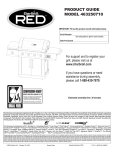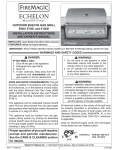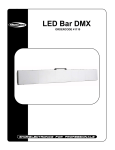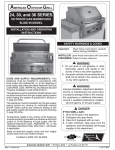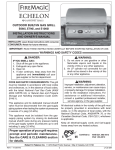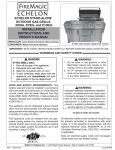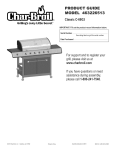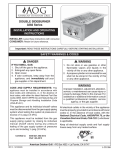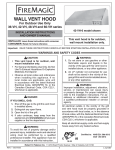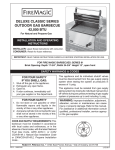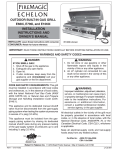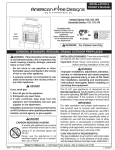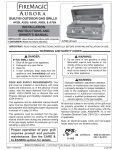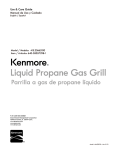Download C2-177 AOG 24, 30 & 36 Series Portable
Transcript
24, 30 & 36 SERIES OUTDOOR GAS BARBECUES PORTABLE MODEL INSTALLATION AND OPERATING INSTRUCTIONS SAFETY WARNINGS & CODES Important: Read these instructions carefully before starting installation. INSTALLER: Leave these instructions with consumer. CONSUMER: Retain for future reference. WARNING 1. Do not store or use gasoline or other flammable vapors and liquids in the vicinity of this or any other appliance. 2. A propane cylinder not connected for use shall not be stored in the vicinity of this or any other appliance. WARNING CODE AND SUPPLY REQUIREMENTS: This barbecue must be installed in accordance with local codes and ordinances, or, in the absence of local codes, with either the latest National Fuel Gas Code (ANSI Z223.1/NFPA 54), and Natural Gas and Propane Installation Code (CSA-B149.1). This appliance and its individual shutoff valves must be disconnected from the gas supply piping system when testing the system at pressures in excess of ½ psig (3.5 kPa). This appliance must be isolated from the gas supply piping system by closing its individual manual shutoff valves during any pressure testing of the gas supply system at pressures up to and including ½ psig (3.5 kPa). Improper installation, adjustment, alteration, service, or maintenance can cause injury or property damage. Refer to this manual. For assistance or additional information consult a qualified, professional installer, service agency, or the gas supplier. DANGER IF YOU SMELL GAS: 1. 2. 3. 4. All electrical outlets in the vicinity of the barbecue must be properly grounded in accordance with local codes or, in the absence of local codes, with the National Electrical Code, ANSI/NFPA 70, or the Canadian Electrical Code, CSA C22.1, whichever is applicable. Keep all electrical supply cords and fuel supply hoses away from any heated surface. Shut off the gas to the appliance. Extinguish any open flame. Open lid if equipped with an oven. If odor continues, keep away from the appliance, and immediately call the gas supplier or fire department. Certified to ANSI: Z21.58b-2012 CSA: 1.6b-2012 09-06 ROBERT H. PETERSON CO. • 14724 East Proctor Avenue • City of Industry, CA 91746 REV 12 - 1408070950 1 L-C2-177 24,30, et 36 SÉRIES LE GAZ EXTÉRIEUR GRILLE TOUT ENTIER LE MODÈLE PORTATIF INSTALLATION ET CONSIGNES D’UTILISATION AVERTISSEMENTS ET CODES DE SÛRETÉ Important: Lisez ces instructions soigneusement avant de commencer l’installation. INSTALLATEUR: Laissez ces instructions avec le consommateur. CONSOMMATEUR: Maintenez pour la future référence. AVERTISSEMENT 1. Ne pas entreposer ni utiliser de l’essence ni d’autres vapeurs ou liquides inflammables dans le voisinage de l’appareil, ni de proximité de tout autre appareil. 2. Une bouteille de propane qui nest pas raccordée en vue de son utilisation, ne doit pas être entreposée dans le voisinage de cet appareil ou de tout autre appareil. CONDITIONS DE CODE ET D’APPROVISIONNEMENT: Ce barbecue doit être installé selon des codes et des ordonnances locaux, ou, en l’absence des codes locaux, avec l’un ou l’autre le plus défunt code national de gaz de carburant (norme ANSI Z223.1/NFPA 54), et le code d’installation de gaz naturel et de propane (CSA-B149.1). Cet appareil et ses différents robinets d’isolement doivent être démontés du système sifflant d’offre de gaz en examinant le système aux pressions audessus du ½ psig (kPa 3.5). AVERTISSEMENT L’installation inexacte, l’ajustement, le changement, le service ou l’entretien peuvent causer des dommages ou des dégats matériels. Référez-vous à ce manuel. Pour l’aide ou l’information additionnelle consultez un installateur qualifié et professionnel, l’agence de service, ou le fournisseur de gaz. Cet appareil doit être isolé dans le système sifflant d’offre de gaz par fermeture ses différents robinets d’isolement manuels pendant tous les essais sous pression du circuit d’alimentation de gaz aux pressions jusques et y compris le ½ psig (kPa 3.5). Toutes les sorties électriques à proximité du barbecue doivent être correctement fondues selon des codes locaux ou, en l’absence des codes locaux, avec le code électrique national, ANSI/NFPA 70, ou le code électrique canadien, CSA C22.1, qui est jamais applicable. Gardez tout cordon d’alimentation électrique et tuyau d’alimentation en combustible a l’écart des surfaces chauffées. DANGER S’il y a une odeur de gaz: 1. Coupez l’admission de gaz de l’appareil. 2. Éteindre toute flamme nue. 3. Ouvrir le couvercle. 4. Si l’odeur persiste, gardez loin de l’appareil, et appelez immédiatement le fournisseur de gazou le service d’incendie. Certifié à la norme ANSI : Z21.58b-2012 CSA : 1.6b-2012 09-06 ROBERT H. PETERSON CO. • 14724 East Proctor Avenue • City of Industry, CA 91746 REV 12 - 1408070950 2 L-C2-177 TABLE OF CONTENTS 1 SAFETY WARNINGS & CODES 5 PARTS LIST 8 MODEL SPECIFICATIONS 8 STAND-ALONE GRILL DIMENSIONS TABLE 9 INSTALLATION REQUIREMENTS 10 ENSURING PROPER COMBUSTION AIR AND COOLING AIRFLOW 10 EXHAUST REMOVAL 11 INSTALLING THE STAND-ALONE UNIT 11 LOCATION PREPARATION 11 WHEELS AND CASTERS 11 CONNECTING THE GAS SUPPLY 13 SAFE USE & MAINTENANCE OF PROPANE GAS CYLINDERS 15 CHECKING AND CONVERTING GAS TYPE 15 CHECKING AND CONVERTING THE REGULATOR (IF APPLICABLE) 16 CHECKING/CONVERTING THE BURNER ORIFICES 16 MAIN BURNER ORIFICE SIZE CHECKING/CONVERSION 17 BACKBURNER ORIFICE SIZE CHECKING/CONVERSION (IF EQUIPPED) 18 INFRARED BURNER ORIFICE SIZE CHECKING/CONVERSION (IF EQUIPPED) 19 SIDEBURNER ORIFICE SIZE CHECKING/CONVERSION (IF EQUIPPED) 19 SIDEBURNER AIR SHUTTER ADJUSTMENT (IF EQUIPPED) 21 LIGHTING (IGNITION) INSTRUCTIONS 21 ELECTRONIC LIGHTING 21 MANUAL LIGHTING 22 BARBECUE SAFETY INFORMATION & MAINTENANCE 23 ROTISSERIE INSTRUCTIONS (IF EQUIPPED) 24 OPTIONAL INFRARED BURNER OPERATION 25 INSTALLING THE SIDEBURNER SHELF 26 RIGID SHELF INSTALLATION 27 ACCESSORIES 27 THE VAPORIZER PANEL(S) 28 CARE & CLEANING 29 DRIP TRAY 30 NOTES PAGE 31 TROUBLESHOOTING 31 REPLACING THE IGNITOR BATTERY 32 WARRANTY REV 12 - 1408070950 3 L-C2-177 AVERTISSEMENTS Avertissements généraux : • Ce barbecue est pour ultilisation à l’extérieur seulement. Si l’appareil est entreposé à l’intérieur, enlever les bouteilles et les laisser à l’extérieur. • Ne pas ranger le gril immédiatement aprés l’avoir utilisé. le laisser refroidir avant de le déplacer ou de la ranger. Le non respect de cette mesure de sécurité pourrait entraîner un incendie causant des dommages à la propriété, des blessures ou la mort. • Ne pas utiliser cet appareil sous une surface combustible. • Ne pas utiliser cet appareil sous un auvent. Le non respect de cette mesure de sécurité pourrait entraîner un incendie ou des blessures. • Dégagement minimal entre les parois latérales et l’arriére de l’appareil et la construction combustible (45.7 cm à partir des parois latérales et 45.7cm à partir de l’arriére). • Le régulareur de pression de gaz prévu avec cet appareil de cuisson à gaz pour l’extérieur doit être utilisé. Ce régulateur est réglé pour une pression de sortie de 5 pouces de colonne de l’eau pour le gaz naturel, et 10 pouces pour le propane. • LE RÉGULATEUR INCLUS D’APPAREILS EST ÉVALUÉ POUR LE MAXIMUM DE 1/2 (LIVRES PAR POUCE CARRÉ). SI VOTRE OFFRE DE GAZ EST 1/2 PLUS GRAND QUE (LIVRES PAR POUCE CARRÉ), UN RÉGULATEUR ADDITIONNEL DOIT ÊTRE INSTALLÉ AVANT LE BARBECUE. VOIR LA SECTION DE CONDITIONS D’OFFRE DE GAZ POUR LA PRESSION APPROPRIÉE D’OFFRE DE GAZ. • Ne couvrez jamais la surface entière de cuisine ou de gril de gauffreuses ou de casseroles. La surchauffe se produira et les brûleurs ne seront pas très performants quand la chaleur de combustion est emprisonnée au-dessous de la surface à cuire. • Ne pulvérisez jamais l’eau sur une unité chaude de gaz, comme ceci peut endommager des composants de porcelaine ou de fer de fonte. Avertissements de propane : • Une fuite de GPL peut causer une incendie ou une explosion si enflammée entraînant des blessures corporelles graves ou la mort. • Communiquez avec le fournisseur de GPL pour les réparations ou pour disposer de qules bouteille ou du GPL non utilisé. REV 12 - 1408070950 4 L-C2-177 PARTS LIST IMPORTANT This AOG oven and backburner (if equipped) are fully pre-assembled and tested at the factory. 1 DO NOT attempt to remove the oven and backburner from the barbecue prior to or during installation or damage to the connecting gas line and ignitor wiring may occur. The plastic straps that secure the oven to the barbecue unit must be removed and discarded prior to lighting. 2 4 Replacement parts can be ordered from your local AOG dealer. 3 7 8 9 6 5 15 13 14 18 11 21 24 12 22 16 17 24" model shown 23 10 REV 12 - 1408070950 5 L-C2-177 PARTS LIST (Cont.) 24" Item Description Part No. 30" Qty. Part No. 36" Qty. Part No. Qty. 1 36-B-11 1 1. Stainless cooking grid (set of 2 or 3) 24-B-11 1 30-B-11 2. Vaporizer panel 24-B-05 2 30-B-05-03 3 36-B-05 3 3. Main burner 24-B-06 2 24-B-06 3 24-B-06 3 4. Infrared burner (optional) IRB-18 1 IRB-18 1 IRB-18 1 5. Backburner* 24-B-17 1 24-B-17 1 36-B-17 1 6. Thermometer 24-B-10 1 24-B-10 1 24-B-10 1 7. Oven lid 24-B-25 1 30-B-25 1 36-B-25 1 8. Single sideburner shelf* 24-C-02 1 24-C-02 1 24-C-02 1 9. Warming rack* 24-B-02 1 30-B-02 1 36-B-02 1 10. Drip tray with match holder 3083 1 3083 1 3083 1 11. Control panel w/ backburner, w/ sideburner 24-C-26 1 30-C-26 1 36-C-26 1 or Control panel w/o backburner, w/o sideburner 24-C-27 1 30-C-27 1 36-C-27 1 ▲ Electronic ignitor (4 spark) 3199-48 1 3199-48 1 3199-48 1▲ and/or Electronic ignitor (2 spark) 3199-47 1▲ 3199-47 1▲ 3199-47 1▲ 12. ▲ 13. Valve manifold w/ backburner, w/ sideburner 24-C-08 1 30-C-08 1 36-C-08 1 or Valve manifold w/o backburner, w/o sideburner 24-C-34 1 30-C-34 1 36-C-34 1 14. Heat shield 24-B-15 1 30-B-15 2 36-B-15 2 15. Main burner electrode 24-B-04 2 24-B-04 3 24-B-04 3 16. Barbecue knob 3015 2 3015 3 3015 3 17. Backburner / sideburner knob* 3016 1 3016 1 3016 1 24-C-01 1† 24-C-01 1† 24-C-01 1† PR-4 1 PR-4 1 PR-4 1 18. Rigid shelf 19. Convertible regulator (nat. models only) ‡ 20. Propane regulator / hose assembly ‡ 5110-07 1 5110-07 1 5110-07 1 or Natural gas QD hose ‡ 5110-03 1 5110-03 1 5110-03 1 21. Door (left) 24-C-23L 1 30-C-23L 1 36-C-23L 1 22. Door (right) 24-C-23R 1 30-C-23R 1 36-C-23R 1 23. Caster kit (set of 4) 24-C-35 1 24-C-35 1 24-C-35 1 24. Drip tray heat shield 24-B-44 1 24-B-44 1 24-B-44 1 * If equipped ‡ Not shown † If not equipped with sideburner; two rigid shelves are supplied. ▲ Quantities may vary due to burner options. REV 12 - 1408070950 6 L-C2-177 PARTS LIST (Cont.) ROTISSERIE KIT (if equipped) 2 1 3 4 REV 12 - 1408070950 24" Item Description Part No. 30" Qty. Part No. 36" Qty. Part No. Qty. 1. Stainless steel motor 24-B-32 1 24-B-32 1 24-B-32 1 2. 24-B-18 1 24-B-18 1 24-B-18 1 3. Spit prongs (set of 2) Spit rod 5/8" hex 24-B-33 1 30-B-33 1 36-B-33 1 4. Handle knob 24-B-09 1 24-B-09 1 24-B-09 1 7 L-C2-177 MODEL SPECIFICATIONS MODEL SPECIFICATIONS TABLE Table 1 Main burner quantity N/P orifice drill size Backburner* N/P orifice drill size Sideburner* N/P orifice drill size Infrared searing burner* N/P orifice drill size 24" 30" 36" 2 3 3 #46/#1.20 #46/#1.20 #46/#1.20 #54/#65 #54/#65 #54/#65 #53/#63 #53/#63 #53/#63 #46/#1.20 #46/#1.20 #46/#1.20 * If equipped STAND-ALONE GRILL DIMENSIONS TABLE Height Model Width Left to right Floor to top (with oven) Open (A) Depth Front to back Floor to top of shelf Cart base Shelf to shelf Cart base Maximum outer Closed (C) (D) (E) (F) (G) (B) 24" 59" 48 1/2" 37" 25" 50" 22 1/4" 24 3/4" 30" 59" 48 1/2" 37" 31" 56" 22 1/4" 24 3/4" 36" 59" 48 1/2" 37" 37 1/4" 62 1/4" 22 1/4" 24 3/4" E G A B C F D Fig. 8-1 REV 12 - 1408070950 8 L-C2-177 INSTALLATION REQUIREMENTS This grill is designed for outdoor use only. DO NOT use this grill inside a building, garage, enclosed area, or under an unprotected overhead combustible construction. See the EXHAUST REMOVAL section on the following page for details on installing under a patio roof. DO NOT use this grill in or on a recreational vehicle or boat. Combustible Min. 18" Important: The grill is not insulated. Refer to the information below to ensure all required clearances are met. The grill must have a minimum clearance of 18" from combustible materials/items AT ALL TIMES. For the minimum clearances between the grill and any side or rear walls, your setup must fall within one (or more) of the following: (Clearance required for right, left, and rear) Fig. 9-1 Clearance 'A' Diagram A. Clearance between grill and combustible wall • The grill must have a minimum of 18" right, left, and rear clearance from any combustible wall (see Fig. 9-1). B. Clearance between grill and strictly non-combustible wall (i.e. brick wall, see Fig. 9-2) Non-combustible Min. 4" • The grill must have a minimum of 4" right, left, and rear clearance from any non-combustible wall. (To allow for proper ventilation and prevent dangerous overheating.) (Clearance required for right, left, and rear) Fig. 9-2 Clearance 'B' Diagram REV 12 - 1408070950 9 L-C2-177 INSTALLATION REQUIREMENTS (Cont.) The control panel MUST remain removable for servicing and air shutter adjustment (see PARTS LIST). INCORRECT Rear oven lid vent ENSURING PROPER COMBUSTION AIR AND COOLING AIRFLOW Proper airflow (Fig. 10-1) MUST be maintained for the grill to perform as it was designed. If airflow is blocked, overheating and poor combustion will result. Do not block the 1" (2.5 cm) front air inlet along the bottom of the control panel or more than 75% of the cooking grid surface with pans or griddles. YOU MUST PROTECT REAR OVEN VENT FROM PREVAILING WIND Fig. 10-2 Note: The 1" (2.5 cm) front air space also allows access to the drip tray. CORRECT Fig. 10-1 PLACE GRILL SO PREVAILING WIND BLOWS TOWARD FRONT OF GRILL Ventilation Diagram Fig. 10-3 EXHAUST REMOVAL If installed or used under a patio roof, the cooking grid area must be fully covered by an exhaust hood with a vent. An exhaust fan with a rating of 1,000 CFM (cubic feet per minute) (472 liters per second) or more may be necessary to effectively remove smoke and other cooking by-products from the area under the hood. This outdoor grill must not be used under unprotected overhead combustible construction. THIS UNIT MUST NOT BE LOCATED IN A FULLY ENCLOSED AREA OF ANY KIND. REV 12 - 1408070950 10 CAUTION: Wind blowing into or across the rear oven lid vent (Fig. 10-2) can cause poor performance and/or dangerous overheating. Orient the grill so that the prevailing wind blows toward the front of the grill (Fig. 10-3). GAS SUPPLY AND MANIFOLD PRESSURES: For natural gas - normal 7" (17.78 cm) water column (w.c.), minimum 5" (12.7 cm), maximum 10 1/2" (26.7 cm). For propane gas - normal 11" w.c., minimum 10" (25.4 cm), maximum 13" (33 cm). L-C2-177 INSTALLING THE STAND-ALONE UNIT LOCATION PREPARATION Prepare a flat, level surface capable of supporting the weight of the stand-alone grill and convenient to the gas supply if connecting to a gas line. WHEELS AND CASTERS LOCK To lock a caster press down on the left lever until it stops and the caster will not turn. To unlock, press down on the right lever. UNLOCK Fig. 11-1 CONNECTING THE GAS SUPPLY Always ensure the orifices and regulator (if equipped) are set for the gas type your unit is to be installed to. For connecting a propane unit to a portable propane tank, read the safety warnings and follow the instructions in the section SAFE USE AND MAINTENANCE OF PROPANE GAS CYLINDERS. For household propane or natural gas units: a. Turn OFF the gas supply at the source. The quick disconnect hose is pre-installed on the valve manifold at the manufacturer. Run the hose through the hole in the bottom rear of the stand-alone unit, to the gas supply. Connect the 1/2" NPT socket at the end of the hose to the gas supply. Use pipe joint compound that is resistant to all gasses on the male pipe fitting and tighten securely. DO NOT use pipe joint compound to connect the flare fittings. c. Turn all burner valves to the OFF position. Turn the gas supply on. Then carefully check all gas connections for leaks with a brush and soapy water before lighting. NEVER USE A MATCH OR OPEN FLAME TO TEST FOR LEAKS. REV 12 - 1408070950 11 L-C2-177 INSTALLING THE STAND-ALONE UNIT (Cont.) INSTALL THE VAPORIZER PANELS Place the vaporizer panels directly onto the studs on the burners. The panels allow heat from the burners to be evenly distributed throughout the cooking area. The panels are stainless steel and will heat and cool quickly, making your barbecue very responsive to the changes you specify in grill temperature. They are rust resistant and may be cleaned with standard oven cleaners. Some discoloring will be seen with use. This is normal for stainless steel and does not affect the function. Place onto studs Fig. 12-1 Install vaporizer panels REV 12 - 1408070950 12 L-C2-177 SAFE USE & MAINTENANCE OF PROPANE GAS CYLINDERS IMPORTANT FOR YOUR SAFETY READ AND FOLLOW ALL WARNINGS PROVIDED WITH THE PROPANE-GAS CYLINDER. When operating this appliance with a propane-gas cylinder, these instructions and warnings MUST be observed. FAILURE TO DO SO MAY RESULT IN A SERIOUS FIRE OR EXPLOSION. CYLINDER/CONNECTOR REQUIREMENTS a. Propane-gas cylinders, valves, and hoses must be maintained in good condition and must be replaced if there is visible damage to either the cylinder or valve. If the hose is cut or shows excessive abrasion or wear, it must be replaced before using the gas appliance (see e.). The use of pliers or a wrench should not be necessary. Only cylinders marked “propane” may be used. To disconnect: Turn the hand nut counterclockwise until detached (Fig. 13-1). Important: Before using the unit, and after each time the cylinder is removed and reattached, check the hose for wear (see a.) and check all connections for leaks. Turn off the unit valves and open the main cylinder valve, then check connections with soapy water. Repair any leaks before lighting the unit. CAUTION: Always turn the propane cylinder main valve off after each use, and before moving the unit and cylinder or disconnecting the coupling. This valve must remain closed and the cylinder disconnected while the appliance is not in use, even though the gas flow is stopped by a safety feature when the coupler is disconnected. b. This unit, when used with a cylinder, should be connected to a standard 5-gallon (20 lb.) propane-gas cylinder equipped with an OPD (Overfill Prevention Device). The OPD has been required on all cylinders sold since October 1,1998, to prevent overfilling. c. Cylinder dimensions should be approximately 12" (30.5 cm) in diameter and 18" (45.7 cm) high. Cylinders must be constructed and marked in accordance with the Specifications for Propane Gas Cylinders of the U.S. Department of Transportation (D.O.T.) or the National Standard of Canada, CAN/CSA-B339, Cylinders, Spheres, and Tubes for Transportation of Dangerous Goods. d. The cylinder used must include a collar to protect the cylinder valve, and the cylinder supply system must be arranged for vapor withdrawal. e. The pressure regulator and hose assembly (Fig. 13-1) supplied with this outdoor gas appliance (L.P. models only) must be used. Original and replacement pressure regulator and hose assemblies must be those specified by the manufacturer for connection with a cylinder connecting device identified as Type I by the ANSI Z 21.58-2005/CGA 1.6-2005 (see PARTS LIST for ordering information). f. Carefully inspect the hose assembly each time before the gas is turned on. A cracked or frayed hose must be replaced immediately. If the appliance is stored indoors, the cylinder must be disconnected and removed. Disconnected cylinders must be stored outdoors, out of the reach of children, with threaded valve plugs tightly installed, and must not be stored in a building, garage, or any other enclosed area. FOR YOUR SAFETY The propane-gas cylinder valve must be equipped with a cylinder connection coupling device, described as Type I in the standard defined in paragraph e. above. This device is commonly described as an Acme thread quick coupler. g. If the propane-gas cylinder comes with a dust plug, place the dust cap on the cylinder valve outlet whenever the cylinder is not in use. QUICK COUPLER OPERATION To connect the regulator/hose assembly to the propanegas cylinder valve fitting: Press the hand nut on the regulator over the Acme thread fitting on the cylinder valve. Turn the hand nut clockwise to engage the threads and tighten until snug. 13 a. DO NOT store a spare propane-gas cylinder under or near this appliance. b. NEVER fill the cylinder beyond 80-percent full. c. IF THE INFORMATION IN a. AND b. IS NOT FOLLOWED EXACTLY, A FIRE CAUSING DEATH OR SERIOUS INJURY MAY OCCUR. Fig. 13-1 Type I Acme thread quick coupler QCC Type 1 valve Pressure relief valve Hand wheel Brass Acme thread fitting Regulator UL Liquid level indicator (optional) Hand nut with Acme thread Vent Hose UTILISATION SÛRE ET ENTRETIEN DES CYLINDRES DE GAZ DE PROPANE IMPORTANT POUR VOTRE SÛRETÉ LISEZ ET SUIVEZ TOUS LES AVERTISSEMENTS ÉQUIPÉS DE VOTRE CYLINDRE DE GAZ DE PROPANE. En actionnant cet appareil avec un cylindre de gaz de propane ON DOIT observer ces instructions et avertissements. LE MANQUE DE FAIRE AINSI PEUT AVOIR COMME CONSÉQUENCE UNE INCENDIE OU UNE EXPLOSION SÉRIEUSE. main dans le sens des aiguilles d’une montre pour engager les CYLINDRE ET CONDITIONS ET fils et pour serrer jusqu’à ce que douillettement. L’utilisation des CARACTÉRISTIQUES DE CONNECTEUR pinces ou de la clé ne devrait pas être nécessaire. Seulement a. Des cylindres et les valves de gaz de propane doivent être le propane marqué par cylindres doit être employé. maintenus en bon état et doivent être remplacés s’il y a Pour débrancher: Tournez l’écrou de main dans le sens des dommages évidents au cylindre ou à la valve. b. Ce gril, une fois utilisé avec un cylindre, devrait être relié à contraire des aiguilles d’une montre jusqu’à isolé (fig. 14-1). c. d. e. f. g. un gallon de la norme 5 (20lb.) cylindre de gaz de propane équipé d’un OPD (remplissez au-dessus du niveau le dispositif d’empêchement). L’OPD a été exigé sur tous les cylindres vendus depuis octobre 1.1998 pour empêcher le remplissage excessif. Les dimensions de cylindre devraient être approximativement 12"(30.5cm) de diamètre et 18" (45.7cm) hauts. Des cylindres doivent être construits et marqués selon les caractéristiques pour des cylindres de gaz de propane du département des ETATS-UNIS du transport (D.O.T.) ou le niveau national du Canada, du CAN/CSA-B339, des cylindres, des sphères et des tubes pour le transport des marchandises dangereuses. Le cylindre doit inclure un collier pour protéger la valve de cylindre et le circuit d’alimentation de cylindre doit être assuré le retrait de vapeur. Le montage du régulateur de pression et le flexible (Fig. 14-1) fourni avec cet appareil au gaz en plein air (modèles au propane seulement) doit être utilisé. Assemblées d'origine et régulateur de pression et le tuyau de remplacement doivent être ceux spécifiés par le fabricant pour le raccordement d'un dispositif de cylindre de liaison identifiée comme de type I par le 21.58-2005/CGA ANSI Z 1.6 à 2005 (voir liste des pièces pour les informations de commande). La valve de cylindre de gaz de propane doit être équipée d’un dispositif d’accouplement de raccordement de cylindre, décrit comme type I dans la norme définie dans le e. de paragraphe ci-dessus. Ce dispositif est généralement décrit comme coupleur rapide de fil de point culminant. Si votre cylindre de gaz de propane vient avec une prise de la poussière, placez le bouchon anti-poussière sur la sortie de valve de cylindre toutes les fois que le cylindre n’est pas en service. Important: Avant d’employer le gril, et ensuite chaque fois que le cylindre est enlevé et rattaché, examinez tous les raccordements pour déceler les fuites. Arrêtez les valves de gril et ouvrez la valve principale de cylindre, puis vérifiez les raccordements avec de l’eau savonneux. Réparez toutes les fuites avant d’allumer le gril. ATTENTION: Tournez toujours la valve principale de cylindre de propane au loin après chaque utilisation, et avant de déplacer le gril et le cylindre, ou débrancher l’accouplement. Cette valve doit rester fermée et le cylindre a débranché alors que l’appareil n’est pas en service, quoique l’écoulement de gaz soit arrêté par un dispositif de sûreté quand le coupleur est débranché. Inspectez soigneusement l’ensemble de tuyau chaque fois avant que le gaz soit allumé. Un tuyau fissuré ou effiloché doit être immédiatement remplacé. Si l'appareil est stocké à l'intérieur, le cylindre doit être disconnected et a enlevé. Des cylindres Disconnected doivent être stockés dehors, hors de la portée des enfants, avec les prises de valve filetées étroitement installées, et ne doivent pas être stockés dans un bâtiment, le garage, ou n'importe quel autre secteur inclus. POUR VOTRE SÛRETÉ OPÉRATION DE COUPLEUR RAPIDE a. Ne stockez pas un cylindre de gaz disponible de propane dessous ou ne vous approchez pas de cet appareil. b. Ne remplissez jamais cylindre au delà de 80 pour cent de plein. c. SI L’INFORMATION DANS “A” ET “B” N’EST PAS SUIVIE EXACTEMENT, UN FEU CAUSANT LA MORT OU DES DOMMAGES SÉRIEUX PEUT SE PRODUIRE. Fig. 14-1 type coupleur rapide de fil de point culminant d’I Volant de commande QCC Type 1 4 1 Ajustage de précision 3 en laiton de fil de point culminant Régulateur Valve Pour relier le regulator/hose à l’ajustage de précision de valve de cylindre de gaz de propane: Serrez l’écrou de main sur le régulateur au-dessus de l’ajustage de précision de fil de point culminant sur la valve de cylindre. Tournez l’écrou de 14 Valve de décompression UL 2 Indicateur de niveau de liquide (facultatif) Écrou de main avec le fil de point culminant. Passage Tuyau CHECKING AND CONVERTING GAS TYPE This unit comes from the factory configured for one type WARNING of gas, as marked on the label located behind the control HAZARDOUS OVERHEATING WILL OCCUR IF A panel, or on the interior of the unit’s enclosure. NATURAL-GAS ORIFICE IS USED WITH PROPANE Converting this unit to burn a different type of gas GAS. IF YOU ARE NOT SURE IF THE CORRECT requires a conversion kit (contact your dealer for ORIFICES ARE INSTALLED, OR IF AN ORIFICE details). The professional installer who converts this CHANGE IS NECESSARY, REFER TO THE FOLLOWING unit to burn a different gas must perform the following INSTRUCTIONS. functions: CAUTION: Make sure the unit is at a safe temperature and isolated from gas and electrical 1. Change brass gas orifices (included at original shipping) supplies before beginning the tasks on each burner to match the new gas type (see outlined below. PRODUCT DATA TABLE, Table 1). 2. If applicable, switch the convertible gas regulator (originally equipped only on natural gas models) to match the new gas type (see section below). Note: The cooler the unit, the greater the tolerances between the stainless-steel parts, and therefore the easier to disassemble and reassemble parts of the unit. Note: Models to be connected to a household propane or natural gas line require the regulator. For models to be connected to L.P. Cylinders, the regulator is optional. CAUTION: For your safety, exercise caution and use adequate hand protection (such as gloves) when handling potentially sharp sheet-metal parts. 3. Plumb the unit as appropriate for the new gas supply. 4. Apply the label for the new gas (included at original shipping) over the old gas information found on your unit. CHECKING AND CONVERTING THE REGULATOR (if applicable) Regulator: note cap on top Note: Each end of the plastic converter is engraved with either the letters “NAT” or “L.P.” (propane) for the respective gasses. When the converter is in the cap and the cap is held uppermost, the letters seen indicate the gas that the regulator is set up for. To convert the regulator from one gas to another, follow steps 1-4. STEP 1: Unscrew and remove the cap from the regulator, extracting the converter. Read gas type here STEP 2: Remove the converter (the plastic stalk) by carefully pulling it away from the center of the cap (it will snap out of its seating). STEP 3: Turn the converter around and replace it carefully, into the center of the cap (it will snap into place). Check that you can read the type of gas the unit is set for. STEP 4: Replace the unit into the regulator and screw down until snug. WARNING THIS APPLIANCE REGULATOR IS RATED FOR 1/2 PSI MAXIMUM. IF YOUR GAS SUPPLY IS GREATER THAN 1/2 PSI, AN ADDITIONAL REGULATOR MUST BE INSTALLED TO REDUCE THE INPUT PRESSURE TO THE UNIT to 1/2 PSI OR LESS. SEE GAS-SUPPLY REQUIREMENTS SECTION FOR PROPER GAS-SUPPLY PRESSURE. 15 CHECKING/CONVERTING THE BURNER ORIFICES MAIN BURNER ORIFICE SIZE CHECKING/ CONVERSION Before beginning, make sure you have the proper tools for the task. This task requires: • a #2 Phillips-head screwdriver • a deep 3/8" nut driver with a spacer (#6 nut) Note: It may be necessary to remove the rotisserie rod before beginning this procedure. 1. Remove cooking grids & vaporizer panels from the barbecue. 2. Turn the burner valves to the OFF position. Pull the valve knobs from their stems and set them aside. Using a Phillips screwdriver, unscrew the control panel fastener screws, (located on the sides of the control panel) and remove the control panel from the barbecue. Retain the screws for reattaching the control panel. Burner support Removing/inserting main burner. Burner support Burner Clip Hole with orifice Fig. 16-1 Note: Carefully, lift the control panel away from the frame. The spark generator for the ignition system is attached to the inside of the control panel. The spark generator knob need not be detached, but the wires must be unplugged from the generator before the control panel is completely removed (see Fig. 16-2). 3. Slightly pinch and remove the burner clip (located over the rear center of the burner) from the burner support and set aside. Then carefully lift the burner from the burner support and out from the hole in the forward fire wall (see Fig. 16-1). Valve 4. Using a 3/8" socket, remove the orifice from the valve. Access this through the hole in the forward firebox plate (see PARTS LIST and Fig. 16-1). Check the number stamped on the face of the orifice (see Table 1). Repeat for each burner as necessary. 5. If the barbecue does not have the proper orifices installed for the gas supply you intend to use, replace them with the correct orifices. Some orifices were supplied with the barbecue. They may also be obtained from the conversion kit or supplied by your local dealer. Note: A regulator hose will need to be connected for conversion to propane gas. 6. After checking the orifice drill size or replacing the orifice, replace the burner over the orifice fitting, Fig. 16-2 sliding it forward, Spark generator from behind the forward fire wall, so the orifice is centered inside the burner gas inlet, and set it gently onto the burner support. The studs on the bottom back of the burner must each fit through their respective holes in the burner support. This is critical to the safe function of the barbecue. Finally, re-install the burner clip (from step 3) around the burner and into the corresponding holes in the burner support (see Fig. 16-1). INSTALL THE VAPORIZER PANELS Place the vaporizer panels directly onto the studs on the burners. The panels allow heat from the burners to be evenly distributed throughout the cooking area. The panels are stainless steel and will heat and cool quickly, making your barbecue very responsive to the changes you specify in grill temperature. They are rust resistant and may be cleaned with standard Continued on next page Burner Orifice Fig. 16-3 - Burner orifice diagram 16 CHECKING/CONVERTING THE BURNER ORIFICES (Cont.) oven cleaners. Some discoloring will be seen with use. This is normal for stainless steel and does not affect the function. ADJUSTING YOUR BARBECUE Important: This appliance may not light or heat evenly or cook properly unless the air shutters are adjusted following installation (see AIR SHUTTER ADJUSTMENT section). Burner air shutters are easily accessed by removing the control panel. The air shutters are located on the front portion of each burner and have a locking screw that prevents the air shutter from inadvertent movement (see Fig. 17-1). To close or open the air shutters, simply loosen the locking screw, using a long Air shutter stemmed Phillips screwdriver, and turn the air shutter Locking to open or close it. screw Tighten the screws Fig. 17-1 d ow n w h e n t h e desired setting is achieved. a lazy yellow, open the air shutters until the flame is mostly blue. Note: Barbecues in some installations achieve a better air/gas mixture and will ignite more quickly if the valve is first turned beyond HIGH to MEDIUM or LOW for lighting. BACKBURNER ORIFICE SIZE CHECKING/ CONVERSION (IF EQUIPPED) Before beginning, make sure you have the proper tools for the task. This task requires: • a 1/4" nutdriver • a 3/8" wrench or socket screwdriver Note: It may be necessary to remove the rotisserie rod before beginning this procedure. 1. Remove the backburner assembly as follows: a. Remove the backburner electrode mounting screw (1/4" hex) (see Fig. 17-3) and loosen the electrode. Draw the wire attached to the electrode down through the slot in the bottom of the bracket so that the left side of the backburner is free to be removed. b. Remove the backburner mounting screws (1/4" hex) located at the left end of the backburner assembly (see Fig. 17-3). AIR SHUTTER ADJUSTMENT Light the burner to be adjusted in accordance with the LIGHTING INSTRUCTIONS and burn for 2 minutes with the burner control knob set to HIGH and the oven open. After burning for 2 minutes, open the air shutter until the flames lift off, or appear not to be touching the burner. Then begin closing the air shutter until the flames appear to burn while touching the burner ports (Fig. 17-2). If flames are Flame off ports Procedure continued on next page Mounting screws Flame on ports Ignitor screw Electrode Fig. 17-3 Fig. 17-2 - Flame appearance diagram Remove electrode and backburner mounting screws. 17 CHECKING/CONVERTING THE BURNER ORIFICES (Cont.) c. Carefully pull the left end of the backburner forward until the burner can be moved to the left pulling it free from the orifice located on the right side (see Fig. 18-1). before the control panel is completely removed (see Fig. 18-1). d. Using a 3/8" socket, remove the orifice from the orifice holder and check the number stamped on the face. 2. If an orifice change is necessary, replace the orifice with the correctly sized one. 3. Replace the backburner assembly and the electrode by reversing the procedure in steps a. through c. Fig. 18-1 Spark generator 3. Disconnect the ignitor wire from the bottom of the electrode assembly on the infrared burner (see Fig. 18-2). Orifice Backburner Fig. 18-2 Spark generator Fig. 18-1 The backburner orifice can be seen on the right side after removing the backburner. 4. Carefully lift the infrared burner from the burner support and out from the hole in the forward fire wall (see Fig. 18-3). INFRARED BURNER ORIFICE SIZE CHECKING/CONVERSION (IF EQUIPPED) Removing / inserting infrared burner. Before beginning, make sure you have the proper tools for the task. This task requires: • a #2 Phillips-head screwdriver • a deep 3/8" nut driver with a spacer (#6 nut) Note: It may be necessary to remove the rotisserie rod before beginning this procedure. 1. Remove cooking grids & vaporizer panels from the barbecue. 2. Turn the burner valves to the OFF position. Pull the valve knobs from their stems and set them aside. Using a Phillips screwdriver, unscrew the control panel fastener screws, (located on the sides of the control panel) and remove the control panel from the barbecue. Retain the screws for reattaching the control panel. Note: Carefully, lift the control panel away from the frame. The spark generator for the ignition system is attached to the inside of the control panel. The spark generator knob need not be detached, but the wires must be unplugged from the generator 18 Hole with orifice Wire disconnected Burner support Fig. 18-3 5. Using a 3/8" socket, remove the orifice from the valve. Access this through the hole in the forward firebox plate (see PARTS LIST and Fig. 18-3). Check the number stamped on the face of the orifice (see Table 1). 6. If the barbecue does not have the proper orifices installed for the gas supply you intend to use, replace them with the correct orifices. Some orifices were supplied with the barbecue. They may also be obtained from the conversion kit or supplied by your local dealer. Note: A regulator hose will need to be connected for conversion to propane gas. CHECKING/CONVERTING THE BURNER ORIFICES (Cont.) 7. After checking the orifice drill size or replacing the orifice, replace the infrared burner over the orifice fitting, sliding it forward, from behind the forward fire wall, so the orifice is centered inside the burner gas inlet, and set it gently onto the burner support. The tabs on the bottom back of the burner must each fit through their respective slots in the burner support. This is critical to the safe function of the barbecue. 8. Reconnect the ignitor wire to the bottom of the electrode assembly on the infrared burner. SIDEBURNER ORIFICE SIZE CHECKING/ CONVERSION (IF EQUIPPED) Suggested Tools: • a pair of needle-nose pliers • a 5/16" hex nut driver Note: It may be necessary to remove the rotisserie rod before beginning this procedure. 1. Lift the sideburner lid. Then remove the grill and sideburner cap and set them aside. 2. L o c a t e a n d r e m o v e the cotter pin from the sidebur ner assembly underneath the sideburner shelf using needle-nose pliers (Fig. 19-2). Set it aside. Fig. 19-2 Cotter pin 3. Fr o m t h e t o p o f t h e sideburner shelf lift the sideburner upward while rotating the attached tubing underneath away from the orifice near the cart wall. Set it aside. Note: To protect the manifold threads when placing the new orifice, start the threading manually, and then tighten with the nut driver. 4. Use the nut driver to remove the exposed orifice and replace it with the correct orifice for the gas being converted to. (see Table 1 for correct orifice sizes based on burner type and gas type). Note: While the sideburner is still removed it may be convenient to adjust the sideburner air shutter. 6. Re-insert the cotter pin underneath the sideburner assembly using needle-nose pliers. It may be necessary to push downward on the burner assembly from above to fully expose the cotter pin hole. Rotate the inserted cotter pin so that it is flush with the underside of the shelf. 7. Replace the burner cap by centering it on the sideburner assembly and making sure it drops in place. 8. Replace the grill with the grating running front to back so that it drops fully down onto the shelf, allowing the lid to close completely over it. SIDEBURNER AIR SHUTTER ADJUSTMENT (IF EQUIPPED) The flames from a properly adjusted sideburner will touch the burner ports and appear mostly blue. If the flames are orange, “lazy”, or lift off the burner ports, then adjust the sideburner air shutter using the following steps. Sideburner adjustment is the most accessible (not requiring any hardware to be removed first) Fig. 19-3 and is located underneath the sideburner shelf on the left side of the barbecue, near the wall of the cart. The sideburner air shutter can safely and easily be adjusted while the sideburner is lit. CAUTION: Do not touch the sideburner or the shelf immediately around it. They will be hot while adjusting the sideburner air shutter. 1. Light the sideburner following the lighting instructions in this manual. 2. Loosen the sideburner air-shutter adjustment screw, then use the tip Close of the screwdriver to Open open or close the air shutter until the flames appear blue and touch Fig. 19-4 the burner ports. 3. Re-tighten the adjustment screw. 5. Rotate the burner assembly back into place over the orifice so that the orifice is centered deeply into the burner pipe and the burner firmly seated in the shelf. 19 ALLUMER DES INSTRUCTIONS (D’ALLUMAGE) Lisez l’instruction entière avant que s’allumant et suivez ces instructions chaque fois vous lumière le barbecue. Note: Les barbecues dans quelques installations ÉCLAIRAGE ÉLECTRONIQUE réalisent un meilleur mélange d’air/gas et mettront 1. Ouvrez tous les couvercles et enlevez toutes les couvertures à feu plus rapidement si le bouton de commande de des brûleurs que vous souhaitez vous allumer. brûleur est d’abord tourné au delà de la LUMIÈRE de HI au BAS pour l’éclairage. 2. Arrêtez tous les boutons de commande de gaz à leurs positions. ÉCLAIRAGE MANUEL 3. Allumez le gaz à sa source. Note: Aucune matière que la méthode d’éclairage vous emploient, Read setting Read setting here here n’allument pas F F F le gaz à plus F OO N N R d’un brûleur à la R OFF U TTU O fois. Les brûleurs O TT adjacents de High to HIGH to light barbecue croixLIGHT mettront à feu et l’écoulement de gaz peut être restreint. Fig. 20-1 - Valve control knob OONN RNRN TUTU TOT O ATTENTION: Attendez toujours 5 minutes le gaz à l’espace libre après que n’importe quelle tentative non réussie d’éclairage. 1. Suivez les étapes 1 à 4 (à gauche). HI LIGHT 2. Insérez un allumeur brûlant de butane de long-baril, une allumette brûlante de long-tige, ou une allumette brûlante tenue par un support de prolongation de fil (Fig. 20-2) par les grilles à cuire au brûleur (Fig. 20-3). Pour des backburners, tenez la flamme contre le matériel perforé du brûleur arrière. Pour des sideburners, tenez la flamme contre le brûleur. LOW 3. Tout en tenant l’allumette ou la flamme plus légère à côté du brûleur, enfoncez le bouton de commande approprié de brûleur et tournez-le dans le sens contraire des aiguilles d’une montre dans la position LÉGÈRE de HI. Quand les lumières de brûleur, enlèvent l’allumeur ou s’assortissent. ATTENTION: Si les brûleurs ne s’allument pas dans 5 secondes, enfoncez le bouton de commande et tournez le bouton à AU LOIN. ATTENDEZ 5 MINUTES avant de répéter l’étape 5. Si vous sentez le gaz suivez les instructions sur la couverture de ce manuel. Si les brûleurs ne s’allument toujours pas après que plusieurs tentatives, se rapportent aux instructions pour l’ÉCLAIRAGE MANUEL. Fig. 20-2 - Support d’allumette 4. Enfoncez le bouton de commande pour que le brûleur soit allumé et tournez-le dans la position LÉGÈRE de HI, puis appuyez sur le bouton d’allumage. Une fois que le brûleur s’allume, libérez le bouton d’allumage. 4. Si le brûleur ne s’allume pas, enfoncez immédiatement le bouton et tournez le bouton de commande de brûleur à AU LOIN. ATTENDEZ 5 MINUTES avant de répéter les étapes 2 à 4 des INSTRUCTIONS MANUELLES d’ÉCLAIRAGE. 5. Répétez l’étape 4 pour que chaque brûleur additionnel soit s’est allumé. POUR LE PROPANE SEULEMENT COUPER LE GRIL Les réservoirs de propane sont équipés d’un dispositif d’arrêt de sûreté qui peut ne pas causer le bas ou aucun gaz pressure/flame aux brûleurs si le fonctionnement et allumer des instructions ne sont pas suivis exactement (voir la note importante dans la section de dépannage pour plus de détails.) Pour couper le gril, enfoncez chaque bouton de commande de valve et tournez-le dans le sens des aiguilles d’une montre à la position de repos. Fermez toujours la valve à l’offre de gaz après chaque utilisation du barbecue. Fig. 20-3 - Éclairage manuel RAPPELEZ-VOUS: POUR L’ÉCLAIRAGE MANUEL SÛR, PLACEZ Un ALLUMEUR BRÛLANT D’ALLUMETTE OU De BUTANE PRÈS Du BRÛLEUR - ALLUMEZ ALORS Le GAZ (voyez Fig. 20-3). 20 LIGHTING (IGNITION) INSTRUCTIONS Read entire instructions before lighting, and follow these instructions each time you light the grill. ELECTRONIC LIGHTING MANUAL LIGHTING 1. Open all lids and remove all covers from the burners CAUTION: Always wait five minutes for gas to clear you wish to light. after any unsuccessful lighting attempt. 2. Turn all gas control knobs to their OFF positions. 3. Turn on the gas at its source. OFF OONN RNRN TUTU TOT O Note: No matter which lighting method you use, DO NOT turn Read setting Read setting on the gas here here to more than F FFF OO N N one bur ner R UR TTU O at a time. TOT Adjacent grill High to HIGH to light bu r n e r s w i l l LIGHT cross-ignite, and gas flow may be Fig. 21-1 - Valve control knob restricted. 1. Follow steps 1 through 4 (left). 2. Insert either a burning long-barrel butane lighter, a burning long-stem match, or a burning match held by a wire extension holder (Fig. 21-2) through the cooking grids to the burner (Fig. 21-3). For backburners, hold the flame against the p e r f o r a t e d m a t e r i a l o f t h e b a c k b u r n e r. For sideburners, hold the flame against the burner. HI LIGHT 3. While holding the match or lighter flame next to the burner, depress the appropriate burner control knob and turn it counterclockwise to the HI LIGHT position. LOW Fig. 21-2 - Match holder CAUTION: If the burners do not light within five seconds, depress the control knob and turn the knob to OFF. WAIT FIVE MINUTES before repeating step 4. If you smell gas, follow the instructions on the cover of this manual. If the burners still do not light after several attempts, refer to the instructions for MANUAL LIGHTING. 4. Depress the control knob for the burner to be lit and turn it to the HI LIGHT position, then press the ignition button. Once the burner lights, release the ignition button. When the burner lights, remove the lighter or match. 4. If the burner does not light, IMMEDIATELY depress the knob and turn the burner control knob to OFF. WAIT FIVE MINUTES before repeating steps 2 through 4 of the MANUAL LIGHTING INSTRUCTIONS. Note: Some installations achieve a better air/gas mixture and may ignite quicker if the burner control knob is first turned beyond HI LIGHT to LOW for lighting. 5. Repeat step 4 for each additional burner to be lit. FOR PROPANE ONLY Propane tanks are equipped with a safety shutdown device that may cause low or no gas pressure/flame at the burners if operating and lighting instructions are not followed exactly (See important note in the TROUBLESHOOTING section for more details.) Fig. 21-3 - Manual lighting REMEMBER: FOR SAFE MANUAL LIGHTING, PLACE A BURNING MATCH OR BUTANE LIGHTER BESIDE THE BURNER - THEN TURN ON THE GAS (see Fig. 21-3). SHUTTING OFF THE GRILL To shut off the grill, push in each valve control knob and turn it clockwise to the OFF position. Always close the valve to the gas supply after each use of the grill. 21 BARBECUE SAFETY INFORMATION & MAINTENANCE Each time you use the barbecue, make sure that: DRIP COLLECTION SYSTEM 1. The area around the barbecue is clear of flammable vapors, liquids, and substances such as gasoline, yard debris, wood, etc. 2. There is no blockage of the airflow through the vent space located below the control panel. 3. When using propane gas: a. The special ventilation openings in the enclosure should be kept free and clear of debris (see PLANNING THE LOCATION OF THE BARBECUE). b. If connected to a propane cylinder, the rubber hose attached to the regulator should be carefully inspected before each use. c. The propane cylinder, regulator, and rubber hose should be installed in a location not subject to heating above 125° F (51° C). 4. The burner flames burn evenly along both sides of each burner with a steady flame, which is mostly blue. (Refer to section on AIR SHUTTER ADJUSTMENT.) A proper flame pattern will ensure safe operation and optimal performance. Adjust the air shutter as needed. If burner flames are not normal, check the orifice and burner for insects or insect nests. The drip collector in this barbecue is part of the unit’s main frame and is located below the burners. The drip collector has slots that will allow excess drippings to fall through during cooking, while separating the firebox from the drip tray. Clean the drip tray after each use. The drip collector allows you to brush or scrape residue from the barbecue’s inner liner into the drip tray. Following the manufacturers instructions and regular cleaning of the barbecue’s interior with oven cleaner, will help to prevent grease fires. Periodically check the burners to make sure they are clear of debris. Properly adjusted burner flames burn evenly along both sides of each burner with a steady flame (mostly blue). If burner flames are not normal, check the orifice and burner for insects or insect nests. (See section on CHECKING/CONVERTING THE BURNER ORIFICES for instructions on burner removal and replacement.) Check the burner ports at least annually for blockage by removing the burner (see orifice changing instructions) and visually inspect the gas intake tube for insects and nests. A clogged tube can lead to a fire beneath the grill. 5. The inline gas valve or gas cylinder valve is always shut OFF when the barbecue is not in use. 6. The drip collector hole is clear and unobstructed. Excessive grease deposits can result in a grease fire. 7. The barbecue is free and clear from combustible materials, gasoline, and other flammable vapors and liquids. 8. The sideburner or infrared burner cover (if equipped) must be removed before using the burner. WARNING NEVER cover the entire cooking or grill surface with griddles or pans. Overheating will occur and burners will not perform properly when combustion heat is trapped below the cooking surface. CAUTION: NEVER spray water on a hot gas unit. The grill serial identification number is located on the underside of the drip tray handle. It is recommended that the drip tray first be removed and cleaned / emptied of its contents, then turned over to view. 22 ROTISSERIE INSTRUCTIONS (IF EQUIPPED) CAUTION: WHEN USING THE BACKBURNER; KEEP THE OVEN LID CLOSED TO PREVENT HEAT LOSS, PROVIDE PROPER CONVECTION, AND PROVIDE PROPER VENTING. THIS WILL ENSURE EVEN COOKING TEMPERATURES. 3. Slide the left spit prong onto the rod (and tighten), the meat onto the rod and into the prong, followed by the right spit prong onto the rod and into the meat. Tighten the right spit prong. Be sure the meat is centered and balanced as well as possible. 4. Insert the pointed end of the rod into the motor drive socket and the groove next to the handle into the left support bracket. DO NOT KEEP YOUR OVEN LID OPEN DURING ROTISSING, AS THIS MAY CAUSE PERSONAL INJURY, OR IN SOME CASES, IN WINDY CONDITIONS, DAMAGE TO THE GRILL. 5. Plug in (if necessary) and turn on the rotisserie motor. 6. Light backburner per lighting instructions in this manual (or on drip tray handle) and close oven lid. DO NOT USE THE ROTISSERIE MOTOR IN THE RAIN. DO NOT LEAVE THE MOTOR ON THE GRILL WHEN NOT IN USE. 7. Allow the backburner to preheat for approximately 10 minutes on HI LIGHT setting. 1. Remove the warming rack and cooking grids from the barbecue. The vaporizer panels may also be removed if required. Note: When burning properly, the backburner grating will glow red. The first time it is used the backburner may smoke a little. Tip: Aluminum foil or a baking pan may be placed over the main burners / vaporizer panels, a little forward of center, to catch excess drippings from the meat. Important: Tur n the backbur ner to low or off when stopping the rotisserie to prevent overcooking. 2. Attach the rotisserie motor to the rotisserie mounting on the right side of your barbecue by sliding the bracket attached to the motor onto the tab on the right of the barbecue. The motor should be installed so that the spit rod will fit into the motor drive socket from the left. Spit rod Handle Stainless steel motor Spit prongs 23 OPTIONAL INFRARED BURNER OPERATION The infrared (IR) searing burner (optional) cooks with WARNING a powerful radiant heat. Only handle the infrared burner cover when the grill is cold or with a well-insulated long-handled tool or heat resistant gloves. Cover SIDE VIEW (with cover on) Ignitor electrode NO foreign objects Drippings and other Airborne liquids dust or grease Ignitor electrode Fig. 24-1 Cover Food particles or debris OFF HI LIGHT Fig. 24-2 LOW Light the infrared burner following the LIGHTING INSTRUCTIONS in this manual or printed on the drip tray. Follow these guidelines when operating the Infrared burner: • DO NOT place food on the cooking grid until the IR burner glows orange (Fig. 24-3). Drippings are heated and evaporate instead of sticking to and impairing burner function. Burner ceramic must be protected with cover when burner is not in use. SIDE VIEW (burner on HI LIGHT and glowing orange) Ignitor electrode • For cleaning purposes; always leave your burner on (after cooking) for an additional 5 minutes, to allow for a burnoff period. This is important to keep your burner clean and operating properly. As the burner is self cleaning (at full temperature); avoid the use of cleaners or abrasives. • Do not strike or scratch the burner ceramic as it may chip, crack, or break (Fig. 24-2). Note: Digital thermometer does not give accurate readings for infrared burners. OFF HI LIGHT LOW • When not in use, always cover the infrared burner with the stainless-steel cover. This protects the burner from drippings (from other cooking), airborne particles, and foreign objects (Fig. 24-2). Fig. 24-3 Drips and particles evaporate before hitting infrared burner when cooking at the maximum setting. Note: Flavor grids are not to be used with infrared burners. Important: When grilling with the infrared burner, always place a cooking grid above it. The cooking grid must be removed for rotisserie cooking. To ensure proper operation, all infrared burners (back and main) must be operated on the HI setting for a minimum of 10 minutes. Thereafter, the flame may be lowered as desired. CAUTION: DO NOT operate your IR burner with the oven hood closed. CAUTION: Always monitor the infrared burner flame when operated on low, as it may blow out in high-wind conditions. CAUTION: Never attempt to operate the IR burner with the protective cover in place. 24 INSTALLING THE SIDEBURNER SHELF This shelf comes separate from the grill for convenience in shipping. The sideburner shelf must be installed using the following instructions before hooking up the grill to a gas source. Shelf Venturi tube Shelf Insulator Ignitor wire Screw AirAir shutter shutter Screw Hole Brass Brass Fig.Fig. 25-1 25-1 INSTALLING THE SIDEBURNER SHELF 1. Remove the protective plastic from the grill, sideburner, and sideburner lids by carefully peeling it off with your fingers. Do not use tools. orifi orifice ce Air-shutter Air shutter orifice placement - under shelf Electrode insulator Female connector 2. Hold the sideburner shelf up against the left side wall of the grill so that the holes in the shelf line up with the four (4) threaded screw holes in the side wall and the air-shutter end of the sideburner venturi tube fits around the brass orifice protruding from the side of the cart. Venturi tube WARNING: Male Ignitor wire Female Fig. 25-2 Connecting the ignitor wires It is critical for safety and for the proper function of the sideburner that the sideburner venturi tube with air shutter be centered around and completely cover the gas orifice. 3. Insert and start screws with fingers and then tighten using a Phillips screwdriver. Note: Upon completion, the air shutter must still fit around the brass orifice. Cap 4. Connect the female female connector connectoron onthe theend endofofthe the ignitor wire to the male ignitor connector hot surface ignitor wire to the male connector protruding from the the bottom coming from inside grill.of the white insulator. 5. Place the burner cap on top of the burner, as shown in Fig. 25-3. Fig. 25-3 6. Place the grid so that it rests on the front and back lips of the sideburner opening (Fig. 25-4). Placing the burner cap Lid 7. Proceed to the section on AIR SHUTTER ADJUSTMENT and complete the installation by adjusting the air shutter. This will also test the sideburner installation. Grate Fig. 25-4 Final look 25 RIGID SHELF INSTALLATION This barbecue barbecue comes comeswith withtwo one(2) rigid shelf that that must rigid shelves be attached. It can be attached using the four support must be attached. These can be attached using the screws provided andprovided a Phillips-head screwdriver. four support screws and a Phillips-head screw driver. 1. Insert the top two screws into the side of the barbecue and screw them in about half way. 2. up shelf the larger, of the two 1. Line Hold the invertedbottom so thatportion one of the corner keyhole with the and fit holes in openings the shelf lines up two withtop thescrews appropriate upper screw hole openings in the barbecue. the two keyhole over the two screws. With the shelf pushed alltighten the way the 2. Insert the screw, but do not all against the way so sidethe of the lower the shelf sothe thatfirst the that shelfbarbecue, can be easily rotated around screws lock into the narrower, upper portions of screw. the keyholes. 3. Line up the second corner hole in the shelf with the The remaining screw holeininplace the barbecue. Note: shelf upper will now stay on it’s Insert a screw and tighten. own. Note: Youthe may lift the of the 3. Insert bottom twoedge screws intoshelf their upward holes and to gain better access tighten them all the way. during much of the tightening of this screw. 4. Finally, tighten the upper two screws, 4. Finally, insert the bottom screws on the left and right completely. side of the shelf and securely tighten all screws. To detach, reverse the process above. To detach, reverse the process above. 26 Shelf support screws View from under right shelf ACCESSORIES WARMING RACK (if equipped) THE VAPORIZER PANEL(S) The warming rack (Fig. 27-2) is packed separately. Place each vaporizer panel directly on a burner or burner pair. Center each panel over the burner, oriented as To install the warming rack, lift the front of the rack up slightly and insert the rack hangers into the two holes shown in Fig. 27-1. in the back of the inner oven hood. Then lower the front Note: This allows heat from the burners to be evenly of the rack into a level position to lock the rack in place. distributed throughout the cooking area. The vaporizer panels heat and cool quickly, making To remove the warming rack, lift up on the front of the the grill very responsive to the changes in heat rack until the rack hangers pull free from their supporting holes. from the burners. Note: Removing the warming rack before using the rotisserie will leave more clearance for the meat being cooked. (if applicable) Fig. 27-1 Fig. 27-2 Warming rack in place inside oven THE DRIP TRAY The drip collection system allows you to brush or scrape excess dried residue from the grilling area directly into the drip tray (see the DRIP TRAY section for more information). 27 CARE & CLEANING APPLIANCE MUST BE COMPLETELY COOL WHEN CLEANING. DO NOT SPRAY ANY CLEANER OR LIQUIDS ON THE APPLIANCE WHEN HOT. The appliance must be cleaned as often as once a month (depending on use) to prevent grease build-up and other food deposits. Wipe with grain INTERIOR THE BURNER PORTS AND CARRY-OVER PORTS/ SLOTS MUST BE KEPT CLEAN TO ENSURE PROPER IGNITION AND OPERATION. Fig. 28-1 - Wipe with grain Remove the burner (see orifice changing instructions) and clean the ports and slots as required. Also inspect and clean the burner inlet for insects and nests. A clogged burner can lead to a fire in the bottom of the appliance. PROTECTING YOUR APPLIANCE FROM THE The inside of the appliance may be cleaned periodically WEATHER with oven cleaner if desired. Follow the oven cleaner An optional cover will protect your appliance when not instructions for proper use. in use. (Allow to cool before covering.) Be careful not to get oven cleaner on the outside surface Please specify the model number and serial number of the appliance as it can permanently damage the finish. of your appliance when ordering a cover. EXTERIOR Stainless steel surfaces when exposed to temperatures produced by the grilling process will change color. The stainless steel will change color from silver to brown and blue. This can be removed by using stainless steel cleaner. Clean your appliance by first using grill cleaner to remove grease and dirt. Always wipe with the grain (See Fig. 28-1). Next, use stainless steel cleaner to restore the stainless steel color (Note: not for mirror finish). Finish by wiping your appliance down using polish wipes. To clean any mirror finish (if applicable), use a quality brand glass cleaner only, not any of the cleaners mentioned above. IMPORTANT IN THE EVENT OF A GREASE FIRE, IMMEDIATELY SHUT OFF THE MAIN GAS VALVE TO THE GRILL. KEEP THE LID OPEN AND ALLOW THE FIRE TO EXTINGUISH ITSELF. A THOROUGH INSPECTION BY A TRAINED SERVICE TECHNICIAN SHOULD BE CONDUCTED BEFORE FUTURE USE OF YOUR GRILL. THE SERVICE TECHNICIAN WILL CHECK THE SYSTEM FOR GAS LEAKS AND WILL CHECK If your appliance is installed in a seaside (salt air) or ALL ELECTRICAL WIRING FOR DAMAGE. ALL GAS poolside (chlorine) location, it will be more susceptible LEAKS AND WIRING MUST BE REPAIRED PRIOR to corrosion and must be maintained/cleaned more TO FUTURE USE. frequently. Do not store chemicals (such as chlorine or fertilizer) near your stainless steel appliance. Due to the nature of stainless steel, surface iron oxide deposits may appear. Do not be alarmed – these deposits are removable with stainless steel cleaner through prompt and periodic maintenance. If not attended to promptly, permanent pitting may occur. By following these recommendations, you will enjoy the beauty and convenience of your appliance for many years to come. 28 DRIP TRAY The drip collection system in this barbecue is part of the unit’s main frame and is located below the burners. The drip collector has slots that will allow excess drippings to fall through during cooking, while separating the firebox from the drip tray. Clean the drip tray after each use. The drip collector allows you to brush or scrape residue from the barbecue’s inner liner into the drip tray. Following the manufacturers instructions and regular cleaning of the barbecue’s interior with oven cleaner, will help to prevent grease fires. Lighting instructions Fig. 29-1 Lighting instruction plate Note: When cleaning the drip tray, the drip tray heat shield will first need to be removed to properly clean/empty the tray of its contents. See section below. A B Note: There are easy to follow lighting instructions etched onto the top of the drip tray handle. Drip tray Tab on inside DRIP TRAY HEAT SHIELD Tab on outside The drip tray heat shield provides protection to the grill controls from high heat. When cleaning the drip tray, the heat shield must be removed. To re-install, slide the front lip of the heat shield into the front portion of the drip tray, then orient the front and side tabs as shown in Fig. 29-2 to properly drop in place. 29 Fig. 29-2 Install drip tray heat shield NOTES PAGE Please use this page to record any information about your unit that you may want to have at hand. 30 TROUBLESHOOTING If you have trouble with the unit, please use this list to identify the problem. By trying one or more of the solutions to the possible cause, you should be able to solve the problem. If this list does not cover your present problem, or if you have other technical difficulties with the unit, please contact your local dealer. PROBLEM Ignition system failure Insufficient heat / low flame Uneven heating POSSIBLE CAUSE 1) Improper air shutter adjustment 1) Adjust air shutters. 2) Ignition wire disconnected 2) Replug wires into generator. 3) Low gas pressure 3) Have gas company check the operating pressure at the unit. 4) Dead battery 4) Replace battery. 1) Improper air shutter adjustment 1) Adjust air shutters. 2) Using propane orifice for natural gas 2) Change orifices. 3) Low gas pressure/flame (natural) 3) Have gas company check the operating pressure at the unit. 4) Low gas pressure/flame (propane) 4) Refill propane tank, or reset propane tank safety*: Shut off all valves (including propane tank) and follow lighting instructions exactly. 5) L.P. regulator hose cracked due to age 5) Replace L.P. regulator hose. 1) Burner ports partially blocked by debris 1) Remove burners and clean out ports. 2) Small spiders or insects in burner 2) Inspect burners for spider webs or other debris that may block gas flow. 1) Va l ve “ L o w ” s e t t i n g n e e d s adjustment 1) Light burner on HIGH, immediately turn to LOW setting. Remove knob from valve and using a small flat screwdriver, slowly turn the adjustment screw in the stem, a little at a time (30° to 45°), in either direction, until the flame is approximately 1/4” in height from burner ports. Burner goes out on LOW Rotisserie noisy CORRECTION 1) Rotisserie out of balance 1) Adjust Adjust counterbalance. the meat on the spit rod. Note: *Propane tanks are equipped with a safety shutdown device that may cause low or no gas/flame at the burners if operating and lighting instructions are not followed exactly. If you suspect the propane tank safety shutoff is in effect, shut off all burner control valves and the propane tank valve. Then read and follow the LIGHTING INSTRUCTIONS exactly. Lighting instructions are located in the owner’s manual. If the problem persists, continue troubleshooting, or contact your local dealer or distributor for assistance. REPLACING THE IGNITOR BATTERY 1. Remove the ignitor cover by turning it counterclockwise. Note: If you have accidentally removed the rubber cap, follow the instructions below to replace it. Important: Do not attempt to pull or turn the rubber cap. 2. Remove batter y for replacement. The battery is reinstalled with the negative (-) end out. 1. Pull the rubber cap and the inner WRONG!! plastic sleeve 3. After properly inserting the apart. battery, replace the ignitor cover by turning the cap clockwise. 31 2. Carefully insert the rubber cap into the ignitor cover so it sits behind inner lip. 3. Tu r n t h e c a p over and slide the inner plastic sleeve into the cap. WARRANTY AMERICAN OUTDOOR GRILL LIMITED WARRANTY American Outdoor Grill warrants your grill to be free from defects in material and workmanship. American Outdoor Grill stainless-steel burners are warranted for FIFTEEN (15) YEARS. All other American Outdoor Grill parts are warranted for TEN (10) YEARS. (Except as noted below.) American Outdoor Grill infrared burners and vaporizer panels are warranted for THREE (3) YEARS. American Outdoor Grill ignition systems (excluding batteries) and accesories (including sideburners, motors, and thermometers) are warranted for ONE (1) YEAR. A COPY OF YOUR SALES SLIP FOR PROOF OF PURCHASE IS REQUIRED This warranty applies to the original purchaser for products which are installed in the United States or Canada and which are operated and maintained as intended for single family residential usage. This warranty is valid only with proof of purchase, shall commence on the date of purchase, and shall terminate (both as to original and any replacement products) on the anniversary date of the original purchase of the product stated on the above schedules. This warranty covers defects in material and workmanship. This warranty does not cover parts which become defective as a result of negligence, misuse, use not in compliance with the Owner’s Manual/Installation Instructions, accidental damage, improper handling, improper storage, improper installation, lack of required routine maintenance (as specified in the Owner’s Manual/Installation Instructions), electrical damage, local gas impurities or failure to protect against combustibles. Product must be installed (and gas must be connected) as specified in the Owner’s Manual/Installation Instructions by a qualified professional installer. Modifications to products which are not specifically authorized will void this warranty. Accessories, parts, valves, remotes, etc. when used must be Peterson products or this warranty is void. Warrantied items will be repaired or replaced at Peterson’s sole discretion. This warranty does not apply to rust, corrosion, oxidation, or discoloration unless the affected part becomes inoperable. This warranty does not cover labor or labor related charges, except as provided by separate specific written programs from the Peterson Co. All repair work must be performed by a qualified professional service person and requires prior approval of Peterson. Peterson may require the defective product or part to be returned to the factory to determine the cause of failure. Peterson will pay freight charges if the product or part is determined to be defective. This warranty does not cover breakage in shipment from our (Independent) distributor to its customer if the damage is determined to have occurred during that shipment. This warranty specifically excludes liability for indirect, incidental, or consequential damages. Some states and provinces do not allow the exclusion or limitation of incidental or consequential damages, so the above exclusion may not apply to you. This warranty gives you specified legal rights, and you may have other rights that vary from state to state or province. For additional information regarding this warranty, or to place a warranty claim, contact the R. H. Peterson dealer where the product was purchased. TO REGISTER YOUR PRODUCT TO: AMERICANOUTDOORGRILL WWW.RHPETERSON.COM, .COM, TO REGISTER YOUR PRODUCT ONLINEONLINE GO TO:GO WWW. AND CLICK ON PRODUCT REGISTRATION. THANK YOU FOR YOUR PURCHASE. Quality Check Burner Orifices Nat. Date:_________________ L.P. Leak Test: ___________ Model#: ___________________ Main: ____ ____ Burn Test: ___________ Serial#: ___________________ Back: ____ ____ Gas Type: Side/Power: ____ ____ Infrared: ____ ____ Other: ____ ____ Nat. / L.P. Air Shutter: ___________________ Inspector: ___________________ Robert H.Outdoor Peterson Grill Co. • •14724 East Proctor Avenue• •City City of Industry, American 14724 Proctor Avenue Industry,CA CA91746 91746 32
































